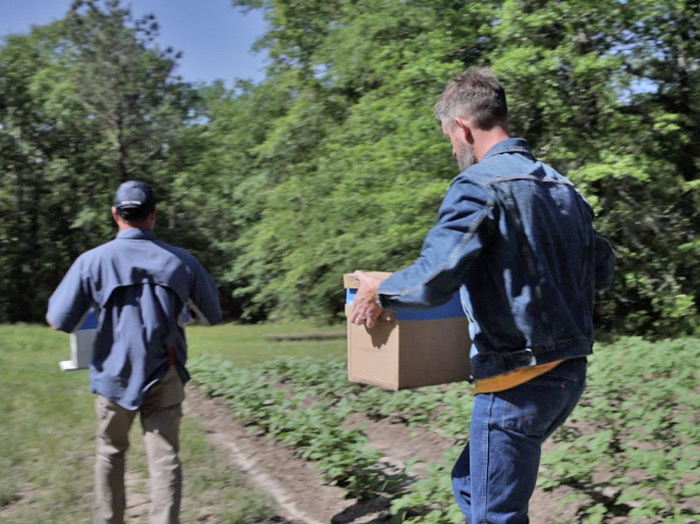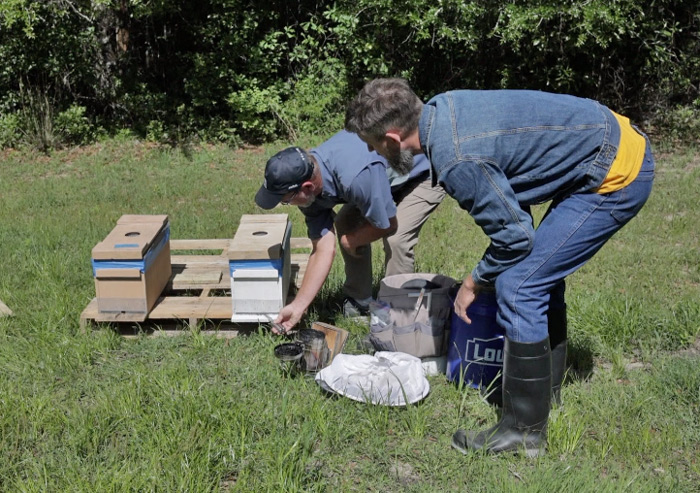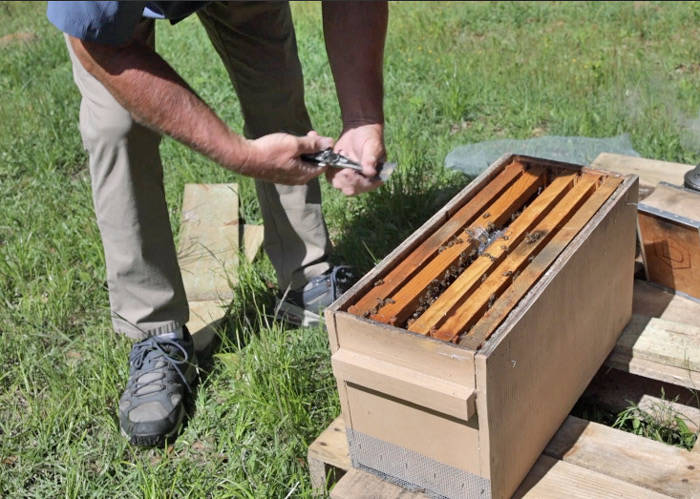It’s been a long time since I kept bees, but my friend Sam from Scrubland Farmz just hooked me up.
He arrived late on Monday the 18th – 11PM – having driven all the way up from the Orange Springs, and we put two nuc boxes of bees in the backyard.
Then on Tuesday morning, we got them properly set up.
The two hives are now near the back of the grassy area behind our gardens.

We put them on a pallet for now.

A nuc box just has five frames in it and is the foundation of a bee colony.

The box on the left has a smaller population and contains a swarm Sam captured. The box on the right is almost full of bees already and came from a colony split.
I plan to keep bees in a few different ways. I’m not convinced that the Langstroth hive design is the best for the bees and am frantically reading as much as I can.
Currently on the bedside table are Keeping Bees with a Smile by Fedor Lazutin and Dr. Leo Sharaskin, as well as The Barefoot Beekeeper by Philip Chandler.
I currently have two Langstroth hives on order so I can transfer these nuc colonies into them and get the bees started, but I would like to move into deep frame horizontal hives.
I also purchased all the materials to make a “Langstroth Long” hive today, which is sort of a hybrid of a Langstroth and a Top Bar hive.
As a side note: making the Langstroth Long hive from Leo Sharaskin’s plans is supposed to cost less than $60; however, with our current runaway inflation it cost me over $200 for the materials! And I don’t even have the frames for them yet! The wood alone was over $100, then we had to get paint, screws, and some router bits… the Langstroth deep hives with frames from Dadant are actually cheaper! The cost of everything is making me sick…
No use complaining, though. We just need to spend our paper trash money on real things before it’s worthless. THINK POSITIVELY!
We can blow it on real things, like making beehives!
I like this Top Bar design from Philip Chandler:
I was never particularly good at keeping bees when I worked with Langstroth hives back in Tennessee, but even experienced beekeepers were losing their colonies en masse there, so I wasn’t alone. Colony Collapse Disorder was a big problem.
I think keeping bees in a more natural way will help immensely. I also think our organic gardens and vast amount of unsprayed swamp, meadows, clover, etc., will be very good for these new colonies.
The gardens and the plant breeding projects are all going to appreciate the pollination, even if we don’t get much honey in our first year.
I’ll keep you posted.


7 comments
You mentioned bees in the new vid… and here you are getting it done.
Yup. The prices of everything are insane.
I recommend keeping this website on hand as well since you are reading up on bees. http://www.bushfarms.com/beeslazy.htm There is a TON on info on bees and I think it would be right up your alley. Michael Bush explains how commercializing bees has changed them and made them weak and susceptible to mites and such and his experiments on fixing them. He agrees with your statement on Langstroth hives possibly not being the best and came up with hives that have the opening on the top. I’ve tried it and it seemed to be working good but I think my box was too big and it got raided and my bees took off on my first attempt after only a few months.
Thank you!
Great job!! I have a few friends and family who keep bees. I get plenty of honey from them. As for my gardens I have plenty of bees and wasps that chase me around constantly. If I had any neighbors they would certainly think I’m crazy as a run around the yard yelling at the bees to get away from me!!! Lol
I used to watch your videos and think, “Wow, David’s gardens are so epic, it would take years and years for me to reach that level of productivity. But at least I’ve got him beat when it comes to livestock.” Ah well, ego is overrated…anyway it’s more motivating to watch people doing things I haven’t done yet.
But I’m curious, are you totally overwhelmed by all the animals you’ve added in the last year or so? Are you just powering through because of the mounting pressure of impending hyperinflation/collapse? They say try not to add more than one new type of animal to your homestead per year if you don’t want to burn out. But desperate times call for desperate measures, right?
Some animals we get, then get rid of. Like the dog is on her way out – too much trouble. And we ate a lot of the chickens. The goats will probably go next. But the cows are doing amazing. We like to learn fast, fail fast, re-asses, press through, re-asses, and have success. We’ll keep our chickens and ducks and cows I am sure. And yes, it’s partly because the collapse is coming. We are trying as much as possible.
I’m in the middle of building several things from Leo’s plans – grateful for his generous resources. Swarm traps are done. Need to make the hives next. I just finished reading Keeping Bees with a Smile (fantastic read) and my mind is fixed on horizontal hives and the spring swarm season! Hope your bees are okay. Keeping bees is something worth learning and doing well, in my opinion, no matter how hard the learning curve.
Comments are closed.